 Amecameca
AmecamecaAmecameca is a small town in the eastern panhandle of the State of Mexico and located approximately 35 miles southeast from Mexico City. At the beginning of the twentieth century it was the home to the brewing industry, several cotton fabric factories, wheat mills, sawmills and small saddlery, pottery and wax workshops. From 1911 the armed movement led in the south by Emiliano Zapata gained followers among the labourers of the area and from 1914 to 1917 Amecameca became an important stronghold of the Ejército Libertador del Sur.
Coin shortages were widespread during the revolution and many states and municipalities under Zapata’s control were prolific in minting coins. Amecameca was no exception and arguably had some of the crudest coinage of the revolution.
Amecameca coinage which is undated, hand-stamped, and incuse in design were authorized by General Trinidad Sánchez Tenorio. Francisco Ponce, a mechanic for the Ferrocarrles de San Rafael & Atlixco, was in charge of making the dies and the blanks. Most, if not all, of the coins were reported to have been minted from metal salvaged from railroad tank cars used in the transport of molasses to a brandy factory owned by the Rojas brothers in the area{footnote}Miguel L. Muñoz, Historia Numismática del Estado de México, Mexico, 1975,{/footnote}. It is believed that these coins were minted during 1915-1916.
[image needed]
5c Amecameca
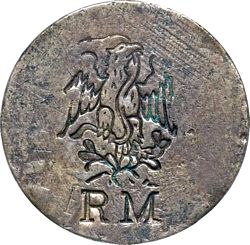
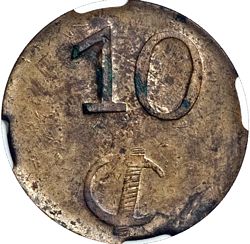
KM-681 Amecameca 10c 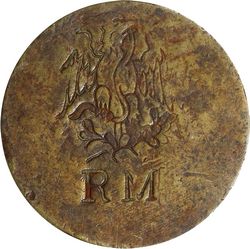
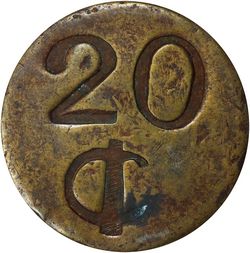
KM-682 Amecameca 20c (Stack’s Bowers Auction, 12 September 2023, lot 73408)
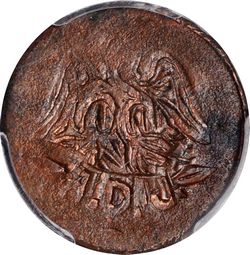
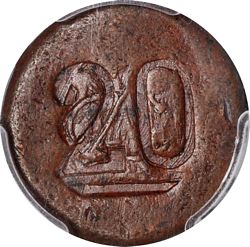
KM-683 Amecameca 20c (Stack’s Bowers Auction, 22 October 2020, lot 72387)
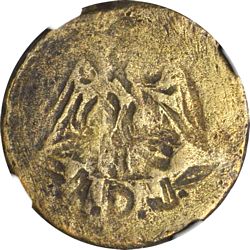
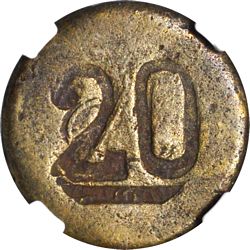
KM-683a Amecameca 20c (Stack’s Bowers NYINC Auction, 15 January 2019, lot 43707)
The Amecameca 20 centavos coins were minted in both brass and copper on various size planchets and consists of basically two primary types. Scott Doll has a detailed study here.

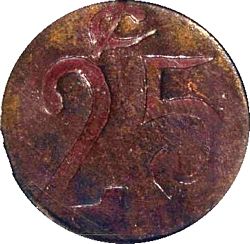
KM-685 Amecameca 25c

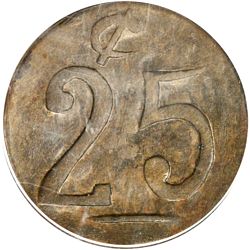
KM-685a Amecameca 25c (Stack’s Bowers iAuction 3527, lot 21369)
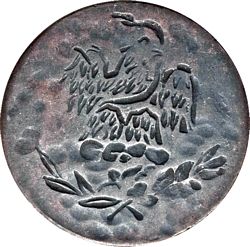
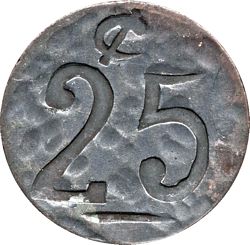
KM-685b Amecameca 25c
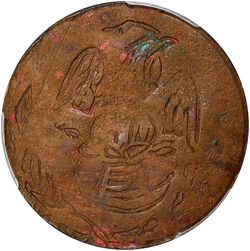

KM-686 Amecameca 50c (Stack’s Bowers Auction, 12 September 2023, lot 73407)
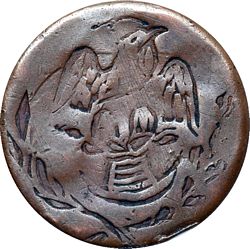

KM-686a Amecameca 50c
At the end of 1915 and in January 1916 General Luciano Solís{footnote}{/footnote} ordered the minting of copper coins worth 2, 5, 10 and 20 centavos. Given the scarce economic resources, a huge copper water tank was dismantled to mint these coins. Trinidad Gallegos was in charge of making the dies and Anastasio Herrera and Rafael Reynoso were in charge of the coining that took place in the house of a Mr. Herrera (it is not known if it was Anastasio's or another) and probably in other houses.
In early February 1916 General Murguía took control of the Estado de México. In Tenancingo he imprisoned Gallegos and his assistants and declared that whoever had these coins would be considered an enemy of the Government and taken prisoner.
The 2c is known with or without "TM" under the denomination.
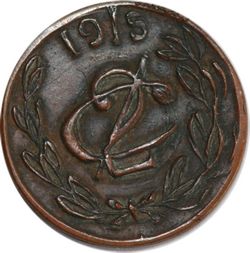
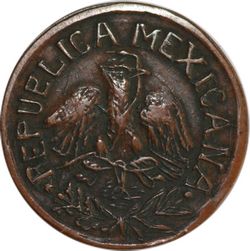
KM-688.1 Tenancingo 2c
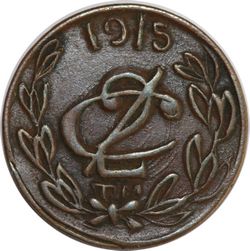
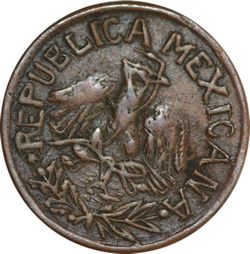
KM-688.2 Tenancingo 2c
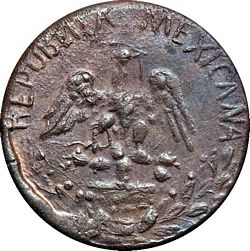

KM-689 Tenancingo 5c
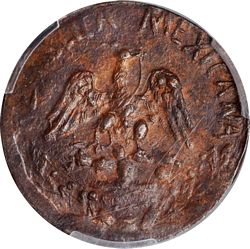
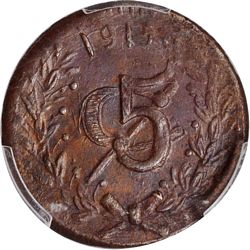
KM-689.1 Tenancingo 5c (Stack’s Bowers Auction, 22 October 2020, lot 7238)
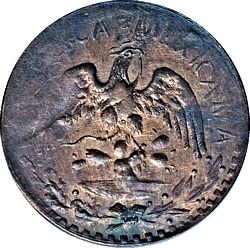
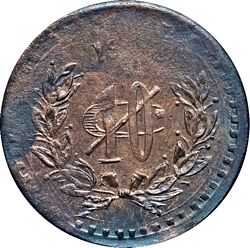
KM-690 Tenancingo 10c
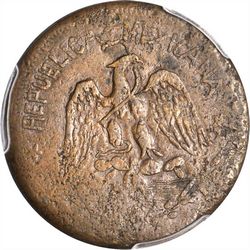
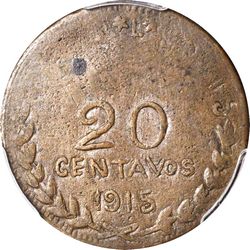
KM-691 Tenancingo 20c (Stack’s Bowers NYINC Auction, 15 January 2019, lot 43707)

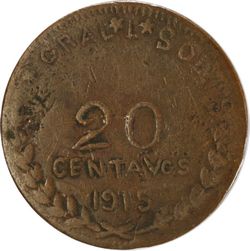
KM-691 Tenancingo 20c

There is a peculiar 1 centavo coin copied from coins in circulation, but made of reddish clay. It is believed that it was manufactured somewhere near Texcoco.
Sánchez Garza{footnote}{/footnote} mentions that a niece of a Constitutionalist General named Gustavo Elizondo{footnote}Gustavo Elizondo was born in Múzquiz, Coahuila, around 1875. He joined the Carrancistas in 1913. Later he supported Alvaro rObregón and seconded the Rebellion of Agua Prieta. He died in !922 in an accident during a hunt.{/footnote} received as a gift from his uncle some clay coins that he obtained when he worked in Texcoco.
However. Amaya believes that these should be classified as fantasies. Someone, in order to counterfeit the 1 centavo coin, made the molds and performed some tests using mud.
[image needed]
Texcoco 1c
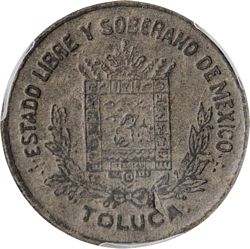
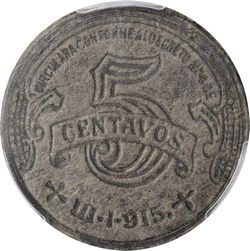
KM-692 Toluca 5c (Stack’s Bowers Auction, 23 October 2019, lot 72617)

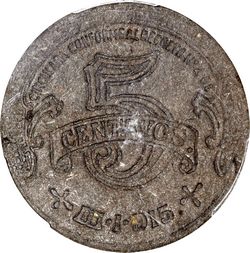
KM-692.1 Toluca 5c (Stack’s Bowers NYINC Auction, 19 January 2022, lot 7852)
These 5c cardboard 'coins' were produced by Gustavo Baz in March 1915.
One and two centavos coins of 1906 and a few of 1905 from Mexico City were restamped with the value of 20 and 40 centavos respectively. Wood{footnote}Howland Wood, The Mexican Revolutionary Coinage 1913-1916, 1921 (available in the USMexNA online library){/footnote} attributed them to Cuernavaca, Morelos; however, Sánchez Garza{footnote}José Sánchez Garza, Historical Notes on Coins of the Mexican Revolution 1913-1917, 1932 (available in the USMexNA online library){/footnote} mentions that some people from Toluca told him that they were restamped there for use at fairs before the Mexican Revolution, specifically they were used in 1906 in some charity fairs, while other people mentioned that they saw them until 1915. Gaytán mentions that these coins were probably stamped by some Conventionista faction. Amaya is inclined to believe that these coins served as tokens in fairs before the Mexican Revolution and the in the time of the war, given the shortage of small change, could have been used in circulation.
The restamp consists of the value "20 or 40" inside a "c" and all within a double circle with transverse stripes inside and is always printed on the reverse of the coin.
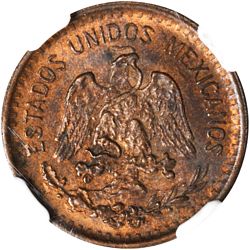
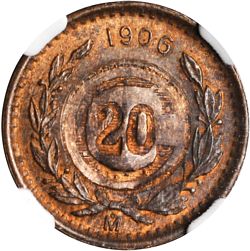
KM-693.1 Toluca 20c (Stack’s Bowers Baltimore Auction, 2014, lot 11386)
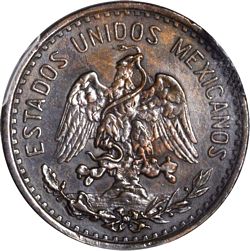
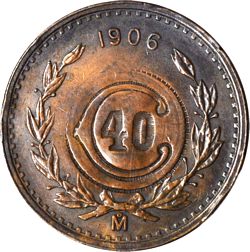
KM-694 Toluca 40c (Stack’s Bowers NYINC Auction, 15 January 2019, lot 43710)
Amecameca is a small town in the eastern panhandle of the State of Mexico and located approximately 35 miles southeast from Mexico City. During the Mexico Revolution (1910-20), this area was one of the strongholds of Emiliano Zapata and his army known as Zapatistas. Coin shortages were widespread during the revolution and many states and municipalities under Zapata’s control were prolific in minting coins. Amecameca was no exception and arguably had some of the crudest coinage of the revolution.
Amecameca coinage which is undated, hand-stamped, and incuse in design were authorized by General Trinidad Sánchez Tenorio. Most, if not all, of the coins were reported to have been minted from metal salvaged from railroad tank cars used in the transport of molasses to a brandy factory in the area. It is believed that these coins were minted during 1915-1916.
The Amecameca 20 centavos coins were minted in both brass and copper on various size planchets and consists of basically two primary types. One type has an obverse that has the National Eagle positioned above the initials RM which stands for REPUBLICA MEXICANA, while the reverse has the denomination (20) located above a large centavo sign. This type is catalogued in Mexican Revolutionary Coinage 1913-1917 by Hugh S. Guthrie and Merrill Bothamley{footnote}Bothamley, Merril and Guthrie, Hugh, Mexican Revolutionary Coinage 1913-1917, Beverly Hills, CA., Superior Stamp and Coin Co., 1976.{/footnote} as GB-248 and in another recent publication, Compendio de la Moneda de la Revolución Mexicana{footnote}Amaya G., Carlos Abel, Compendio de la Moneda de la Revolución Mexicana, Monterrey, NL Mexico, 2010.{/footnote} by Carlos Abel Amaya Guerra, as A-EM 7.
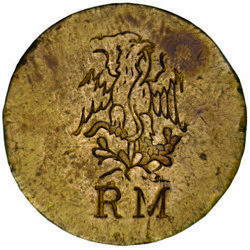
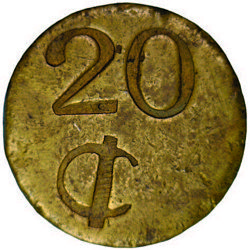
GB-248, A-EM 7 struck in brass (enlarged)
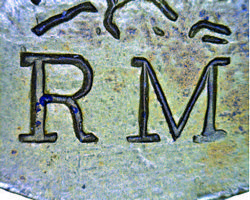
GB-248, A-EM 7 struck in brass (enlarged)
The second type has an obverse with the National Eagle positioned above three diamonds and the initials A.D.J. which is an abbreviation for AMECAMECA DE JUAREZ, while the reverse has the denomination (20) superimposed over a raised centavos sign and is listed by Guthrie and Bothamley as GB-250 and by Carlos Amaya as A-EM 11.
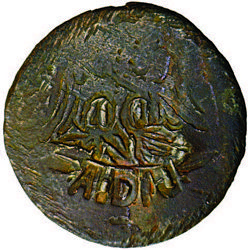

GB-250, A-EM 11 struck in copper (enlarged)
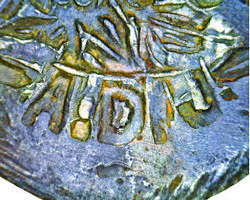
Close up of obverse initials A.D.J. (GB-250, A-EM 11)
The RM type was struck on large 24.5mm, 3mm thick brass planchets and at least two obverse varieties are known to exist. One is commonly referred to as a ‘round’ nopal (cactus) variety, while the other is referred to as the ‘square’ nopal. The round nopal variety is pictured, but not described as such by Guthrie and Bothamley as GB-248 while the square nopal is not pictured nor is it listed within their publication; however Carlos Amaya catalogued this variety in his publication as A-EM 10.
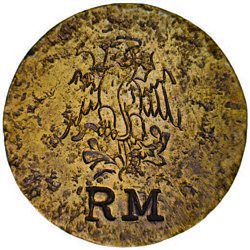

GB-248, A-EM 7 (enlarged), round nopal
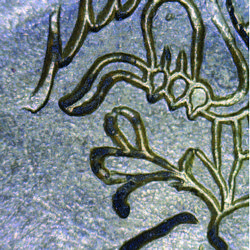
detail of round nopal & non-incuse snake tail
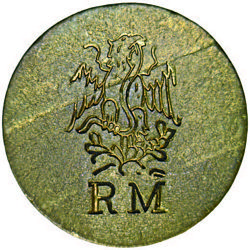
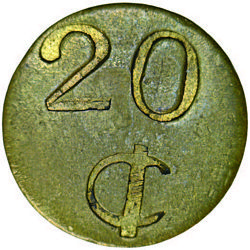
GB-UNL, A-EM 10 (enlarged), square nopal
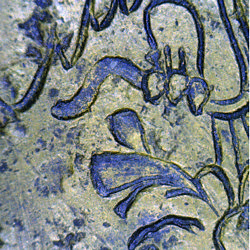
detail of square nopal & incuse snake tail
Although Guthrie and Bothamley didn’t mention any obverse varieties or GB-248 obverse variations, there exist some noticeable differences for the round nopal variety. Specifically, some of the differences include the snake above the eagle’s head (missing or not), line at the top of the eagle’s head and back of the neck (broken or solid line), snake across the eagle’s chest (broken or solid line), and the letter M of the initials RM (solid or broken line). More study would be needed to determine if multiple obverse punches were used, or if these differences are merely due to weak strikes or strikes using worn or damaged punches.
The following four examples are of some differences on the obverse National Eagle.
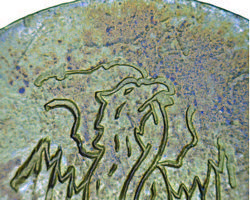
Example #1-1
Example #1-1 – snake above the eagle’s head, solid line at the top of the eagle’s head, back of neck and snake across the chest.
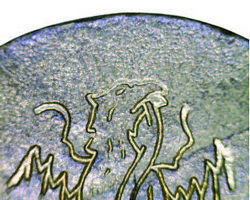
Example #1-2
Example #1-2 – missing snake above the eagle’s head, solid line at the top of the eagle’s head, small broken portion (line) on the back of the neck, solid lines on the snake across the eagle’s chest.
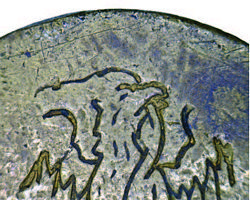
Example #1-3
Example #1-3 – snake above the eagle’s head, broken line at the top of the eagle’s head, solid line on the back of the eagle’s neck, broken line on the snake across the eagle’s chest.
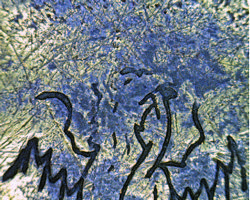
Example #1-4
Example #1-4 – missing snake above the head, broken line at the top of the eagle’s head, broken line on the snake across the eagle’s chest.
The following three examples are of some differences on the obverse initials RM.
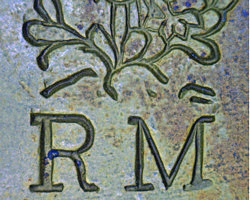
Example #2-1
Example #2-1 – solid lines throughout on the initials RM; as well as two solid notches or lines above the rightside of the letter M.
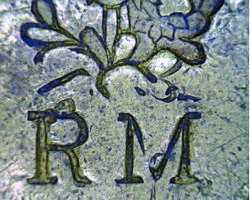
Example #2-2
Example #2-2 – broken line on the initial M of RM; as well as a shortened top notch or line above the right side of the letter M.
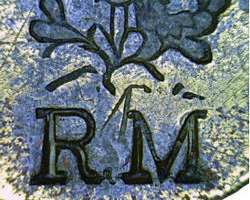
Example #2-3
Example #2-3 – solid line on the initial M of RM; as well as a shortened top notch or line above the right side of the letter M.
The reverse on the round nopal variety is basically the same for each coin except for the placement of the 20 (denomination) and centavos sign which is not always in the same position since each one was individually handstamped; thereby different from coin to coin. Since these were hand-stamped, each coin made is somewhat unique: therefore it shouldn’t necessarily be construed as a separate variety in this author’s opinion.
The following examples of the reverse denomination and centavos sign help highlight some of the many possible variations.
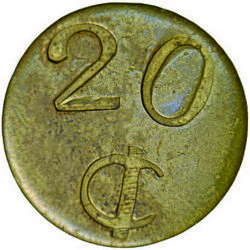
Example #3-1
Example #3-1 – low zero tilted to the right, centavos sign slash tilted to the right and placed very low and center.
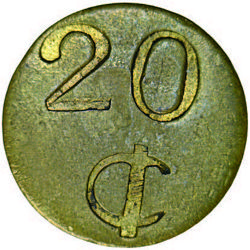
Example #3-2
Example #3-2 – low slightly tilted zero, centavos sign slash tilted to the right placed very low and center.
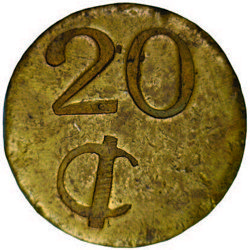
Example #3-3
Example #3-3 – two and zero are almost even, centavos sign slash tilted to the right placed below the two

Example #3-4
Example #3-4 – high slightly tilted zero, centavos sign vertical slash not tilted and centered below the two and the zero.
The square nopal variety die is quite a bit different compared to the round nopal variety. Although the obverse and reverse characteristics are close in overall design to the round nopal variety, it is quite clear that this coin was minted using a completely new set of dies. The square nopal variety is easily distinguished when compared to the round nopal by the square nopal and incuse snake tail. This coin also did not use separate punches as were used for the round nopal and was struck using a fixed position die.
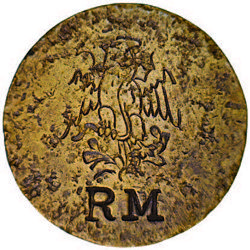

Example #4-1
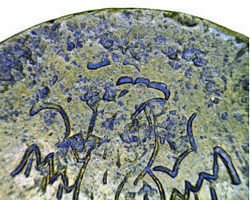
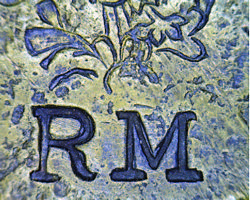
Close up of eagle Close up of RM
Example #4-1: planchet is very pitted and has well defined coin attributes.
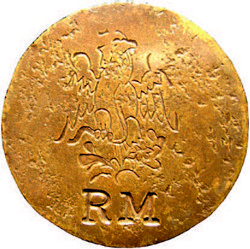
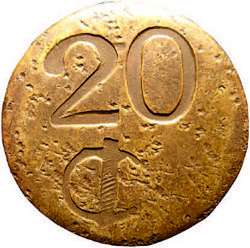
Example #4-2
(photos courtesy of Angel Smith)
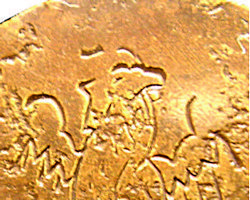
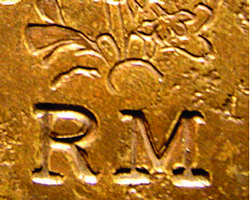
Close up of eagle Close up of RM
Example #4-2: planchet is very pitted like example #4-1 and the coin has the same attributes and die placement such as the National Eagle, denomination, centavos sign and slanted lines within the vertical bar.
Analysis of several square nopal specimens, as well as coin scans, show that each coin is basically the same in regards to the National Eagle, denomination, centavos sign placement; as well as the slanted lines within the vertical bar of the centavos sign. Planchet surface ranges vary from pitted to smooth. Since this coin is so much different than other Amecameca coins of the period, more analysis is needed to see if it is a new variety or possibly spurious.
Another 20 centavos issue from Amecameca which is known as the initials A.D.J. type is generally smaller in size (19.5-20mm vs. 24.5mm) and weight (4.5-5 grams vs. 12-12.5 grams) than the RM type and were struck in copper and brass while the RM type is generally known to have been struck only in brass, although Amaya has catalogued a copper strike (with no photo) as A-EM 9.
One particular A.D.J. variety (GB-251, A-EM 13) was struck on the same size brass planchet as was used for GB-248, A-EM 7 and is considered quite rare. Otherwise, the most common A.D.J. variety comes in copper and is generally crudely struck. There is also an unlisted GB variety of GB-250 struck in brass, which is the same general size and weight as the copper variety and is considered very scarce. Amaya catalogued this coin as A-EM 12.
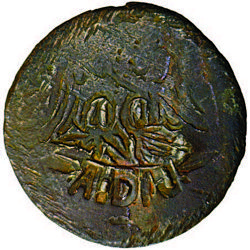
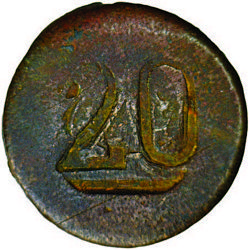
GB-250, A-EM 11 struck in copper (enlarged)

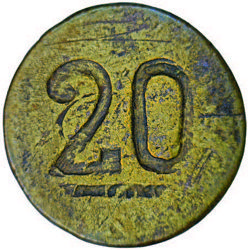
GB-UNL (GB-250), A-EM 12 struck in brass (enlarged)
This coin appears to have been struck using single punches for each side of the coin and did not use separate punches for the denomination, centavos sign, eagle and A.D.J. initials as is seen on the RM type. It is well known that there are at least two sets of obverse and reverse dies (GB-250, A-EM 11 and GB-251, A-EM 13) for this type; however further study is needed to determine if there are any additional punch varieties.
Although any one of the varieties of the Amecameca 20 centavos coins can be viewed as scarce to very scarce, most are not rare by any means. The exceptions are GB-250 (GB-UNL), A-EM 12 struck in brass and GB-251, A-EM 13, neither of which are often offered for sale at shows or auctions. GB-248, A-EM 7 is arguably the most common of the Amecameca 20 centavos and overall a scarce coin. It is hard to say which one of the various obverse eagle and RM die variations is common, scarce or rare. In time, some may become known to be rarer than others, but only through more analysis and detailed study of this series.
Mexico Revolutionary period coinage has been a challenge at times to collect as it is one of the most counterfeited areas in Mexican numismatics due to the crudeness and simplistic designs on many issues, and the apparent ease of counterfeiters to create a fake. This could make collecting this series frustrating, as well as exceedingly difficult since many collectors do not necessarily know the attributes of a legitimate coin compared to a post revolution fake or even a contemporary counterfeit.
The 25 centavos from the municipality of Amecameca has a plain edge, struck in copper, and has no date, but was struck in late 1915 or early 1916 under orders from revolutionary General Trinidad Sánchez Tenorio. Guthrie-Bothamley catalogued this variety as GB-252 and Carlos Amaya as A-EM-16.
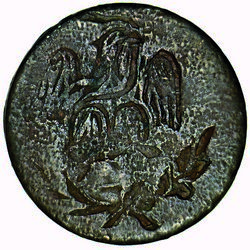
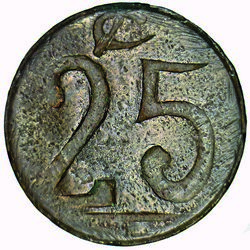
Genuine example
Plain Edge, 25.08 mm, 6.94 g.
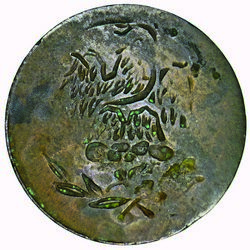

Counterfeit example
Plain Edge, 27.03 mm, 5.99 g.
Let me start by stating that I believe this counterfeit to be a modern fabrication and not something contemporary from the revolutionary period. Although it is entirely possible that it could be a contemporary strike, I strongly feel that it is a modern fake due to the following attribute’s evidence, as well as the fact that these have only been observed in the market since the early 1970s.
I would classify this counterfeit as dangerous since it is well made, and it can be difficult for someone to distinguish from a genuine coin unless you know the attributes of each. Upon a quick glance, the obverse and reverse on a genuine specimen is remarkably like the counterfeit specimen: however, upon closer inspection, it becomes apparent that there are subtle differences to include the centavos sign, the denomination digit design and finally the eagle’s legs and feather lines. Lastly, many genuine pieces have adjustment marks on the planchet while the fakes do not. The genuine pieces also have lathe marks within the “25” (denomination) while the fakes do not.
Let us begin by reviewing the edge or adjustment file marks on this sample genuine specimen, as well as the planchet lathe tool marks which are visible in the stamped area of the denomination on a genuine specimen.
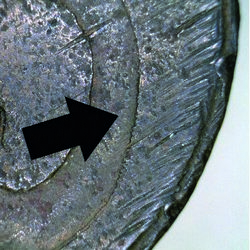
Many pieces show signs of file or adjustment marks which was done prior to the coin being struck. Most counterfeits do not have these marks.
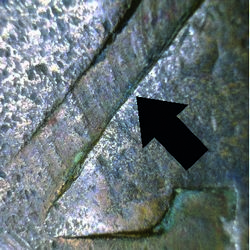
Within the “25” denomination, lathe marks can be easily seen at various areas within the numerals. Counterfeits do not have these marks as their surface looks smooth and flat.
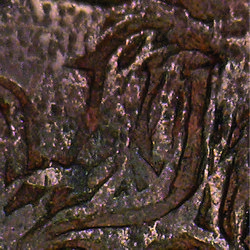
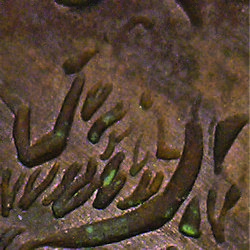
Genuine Counterfeit
The head on a genuine coin is distinct, while the head on the counterfeit is very weak around the area of the beak and top of the head. The feather lines on the genuine are also longer and fewer in number while the counterfeit is shorter and more numerous.
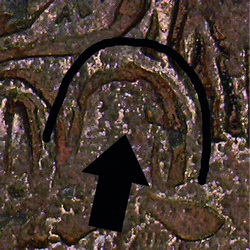
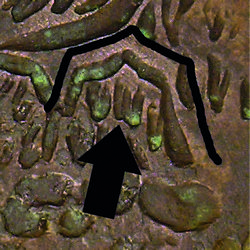
Genuine Counterfeit
The eagle’s legs are the easiest identifier to compare as the genuine strike is more rounded on the top line compared to the counterfeit which has a series of short, mostly straight interconnected lines. The feather lines within are also quite different as the genuine strike only has a couple of lines while the counterfeit has numerous short lines.
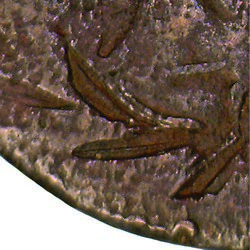
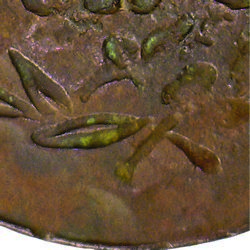
Genuine Counterfeit
The stems and leaves below the eagle on the genuine strike has thick, long stems while the counterfeit has thin, short stems. The leaves on the genuine are also thin, narrow, and not prominently outlined, while the counterfeit strike is wider and a little thicker in size, as well as noticeably outlined.
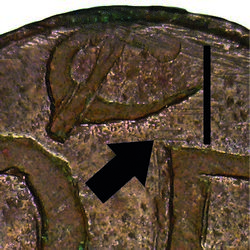
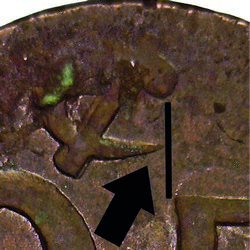
Genuine Counterfeit
The centavos sign is the easiest identifier to compare on the reverse. The genuine strike is positioned in the center area above the “25” denomination and has a long tail at the bottom that extends beyond the top bar of the “5” while the counterfeit is positioned more above the top of the “2” and has a short tail that does not extend beyond the top of the “5”
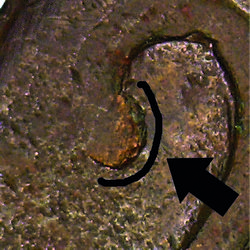
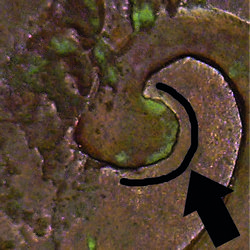
Genuine Counterfeit
TThe ball at the top of the “2” in the denomination on the genuine strike is much smaller in size and proportion, as well as more rounded in shape compared to the counterfeit which is larger and more oval shaped.
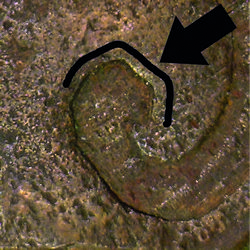
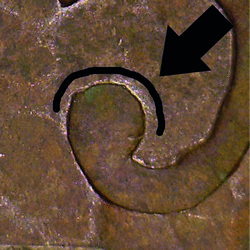
Genuine Counterfeit
The ball at the bottom of the “5” in the denomination on the genuine strike is irregular in shape (not fully rounded) and has a flat or straight area on the top right side, while the counterfeit is much more rounded and proportional in shape.
The genuine variety with an incuse design is known to be crude stamped in copper and reportedly in brass, although I have not yet seen a genuine brass specimen. I would consider the copper genuine strikes to be scarce, while the brass, if they do exist, to be quite rare. As for the counterfeits, these can also be found in copper as well as brass and appear to show up equally as a percentage within the market. Although the planchet metal may be different on the counterfeits, all other attributes mentioned within this article are the same to include the planchet size while the weight is slightly higher on the brass fake.
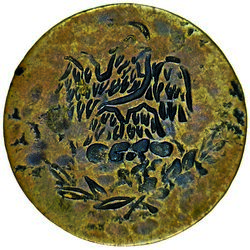
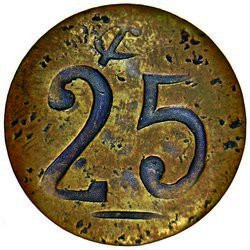
Modern Counterfeit
Plain Edge, 26.95 mm, 7.39 g.
The modern counterfeit Amecameca 25 centavos reviewed within this article is very well made, and as I mentioned earlier, should be considered a dangerous counterfeit: therefore, you should be wary when purchasing this variety unless you understand the key attributes differences since a genuine strike will be quite a bit more expensive and valuable than a counterfeit.
Please send your comments, questions, or suggestions regarding this article, to me at